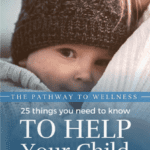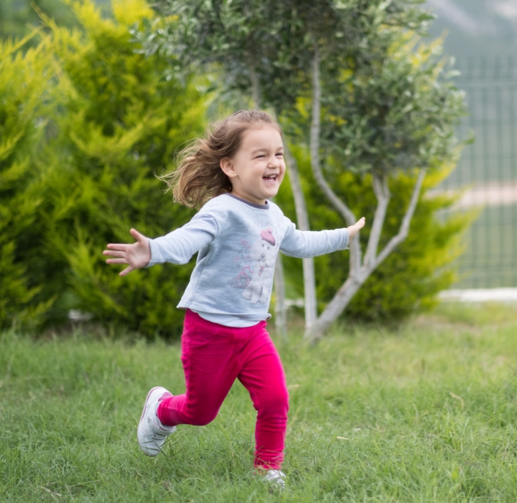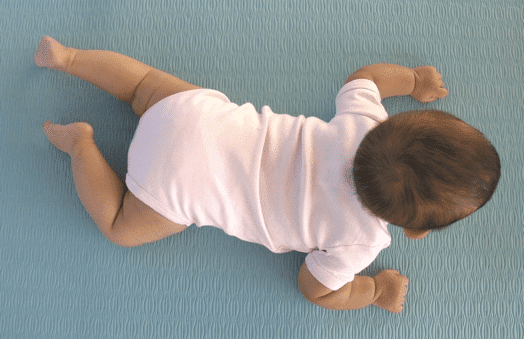Tiny Babies Need to Move
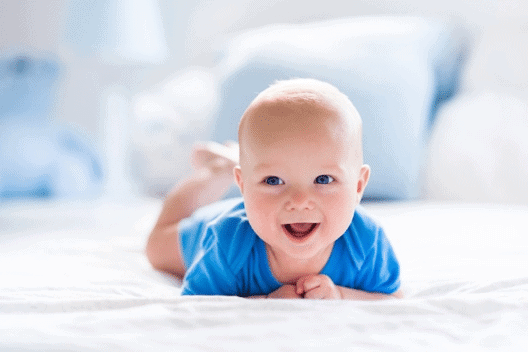
A baby who lives on his belly on the floor is a mobile, happy baby
Let’s take a look at the typical environment of the newborn baby and ask this question: Is it set up for his benefit or ours?
After being delivered he is usually taken away from his mother, wrapped up, and put on his back, and often placed, if mother permits, in a nursery with many other babies.
Our benefit or the newborn’s?
Is this good for him or is it simply more convenient for the hospital staff to keep an eye on him?
Nature has arranged a one mother/one baby ratio so that the newborn baby has mother watching and observing him at all times. We frustrate nature’s design and take baby away so that he is one of a litter of babies that are watched over, not by their own mothers, but by a few conscientious nurses.
To help the nurses keep an eye on so many babies at once, they are placed on their backs so that the nurses can be sure that they are breathing.
The babies are covered in blankets because the nursery is not warm enough for them to be naked. If we made the nursery warm enough for the babies to be naked, then it would be too hot for the nurses.
“Where is my Mother?”
Although the babies cannot see or hear their mothers very well at birth, they can smell their mothers. When they arrive at the nursery they cannot smell mother any more. This is very upsetting for the baby.
His survival imperative tells him, “Keep mother by your side at all times!” Therefore he will cry to call mother to his side. Since mother is a hundred yards away down the hall, she cannot hear his call and does not respond to it. Thus the baby knows his mother is not there and his attempts to call her go unanswered.
Newborns did not design the “Nursery”
This is not a comforting condition for the newborn.
This frightening situation is compounded by the fact that he can hear the loud and repeated cries from the other babies in the nursery who are also trying to call their mothers.
And we call this a “nursery”?
Our intentions may be good but we have set up the environment to suit adult convenience. This environment could hardly be worse for the baby if we had set out intentionally to confuse, frighten, and frustrate him.
When the baby arrives home he will continue to be bundled up no matter what time of year it is. We cool or heat our homes based on what is comfortable for us. But the baby needs a warmer environment than suits us, so he must be bundled up in the first few months of life.
Bundled babies are trapped babies
Wrapped up in blankets and dressed in clothing that fits like a snowsuit, he has a hard time moving at all. He already has a very chubby body that is hard enough to move, but dressed in thick diaper, a long-sleeved and long-legged baby suit, and then wrapped up in blankets, he would have to be a sumo wrestler to escape from the padding that envelops him.

Adorable, chic and utterly immobile. While in utero this baby could move her arms and legs and even turn her body. She experienced all the motion of mother. In this pod she is totally restricted from the neck down and trapped on her back.
And he is desperate to move.
He will move his arms and legs frantically at those rare times when he is freed from the confinement of his clothes and blankets. This is why diapering can be such a trial. It is usually the only time in the day when, for a fleeting instant, he is free. He struggles like mad, which usually drives us crazy since we are trying to put a diaper on him.
Right side up or upside down?
It is not just the clothing and the blankets that frustrate his attempts to move. He is almost invariably placed on his back right from birth. In this position he is like a turtle turned upside down. All of the wonderful propulsive movements of his arms and legs are useless in this position. They produce no forward motion for him.

Upside down, immobile and frustrated
However, when he is placed right-side up on his belly on a smooth, warm surface, all those seemingly random motions of his arms and legs become productive motions that produce forward movement. Whenever he is placed on his belly he will begin to make the thousand and one experiments that he must make to discover how to use his arms and legs to crawl. Nature has provided him with a rage to move his body, and he needs all the time he can get in order to do so.
If you calculate how much time the modern baby is free to move unencumbered on his belly on a smooth, warm surface, you find it is almost zero.

Newborn Rory is making his way down his crawling track coached by his dad and his older brother, Jonah who used the same track 15 months ago. By 3 months Rory crawls off the track and at 5 months he is beginning to creep all over the house.
Convenience versus development
Even when we give him some opportunity to move, we restrict his playing field severely by placing him in a crib, playpen, swing, stroller, or “walker.” Each of these devices was invented to act as a kind of remote babysitter. They are designed to restrict the baby so that we can go about our affairs without having to watch the baby so closely. This may seem like a necessary convenience or even a safeguard for the baby, but, in fact, it is neither convenient in the long run nor safe in the short run.
There is nothing convenient about arranging the environment so that the baby cannot, try as he may, develop the vital abilities to crawl and creep freely.
We know now that these are not just incidental stages in his development; crawling and creeping are critical to all aspects of neurological development. What may seem convenient today will turn out very inconvenient if his lack of creeping and crawling as a baby leads to difficulties later in life.
The baby cannot fall off the floor!
As for safety, with a tiny baby there is no substitute for real vigilance. Every device that allows us to put distance between ourselves and the baby is a device that lulls us into a false sense of security.
We have a clinic full of brain-injured children who were well children who climbed out of their cribs and fell on their heads or climbed out of their playpen and fell into the swimming pool.
The lesson is simple—the closer the baby is to mother and the floor, the safer he will be in both the short run and the long run.
Creating a newborn-friendly environment is the key

This baby cannot move – he needs a user- friendly environment
As parents and as a society, we need to take a careful look at what our priorities are when we decide to bring a baby into this world.
When we take a closer look, we may see that we have been selfish, insensitive, and extremely short-sighted to design the baby’s environment almost totally for our comfort and convenience, thus denying the baby his birthright to move and explore and develop his abilities to their fullest.
Although we have not meant to do so, we have gotten in the way of our babies’ development.
The needs of the newborn are much more important than our own temporary convenience. The environment should be designed to ensure his safety and long-term growth and development.
The family and society as a whole stand to benefit hugely from the increased ability and happiness of babies who are raised in a way that meets their neurological needs.
Excerpt from “How Smart is Your Baby“

Janet Doman, co-author and Director of The Institutes for the Achievement of Human Potential
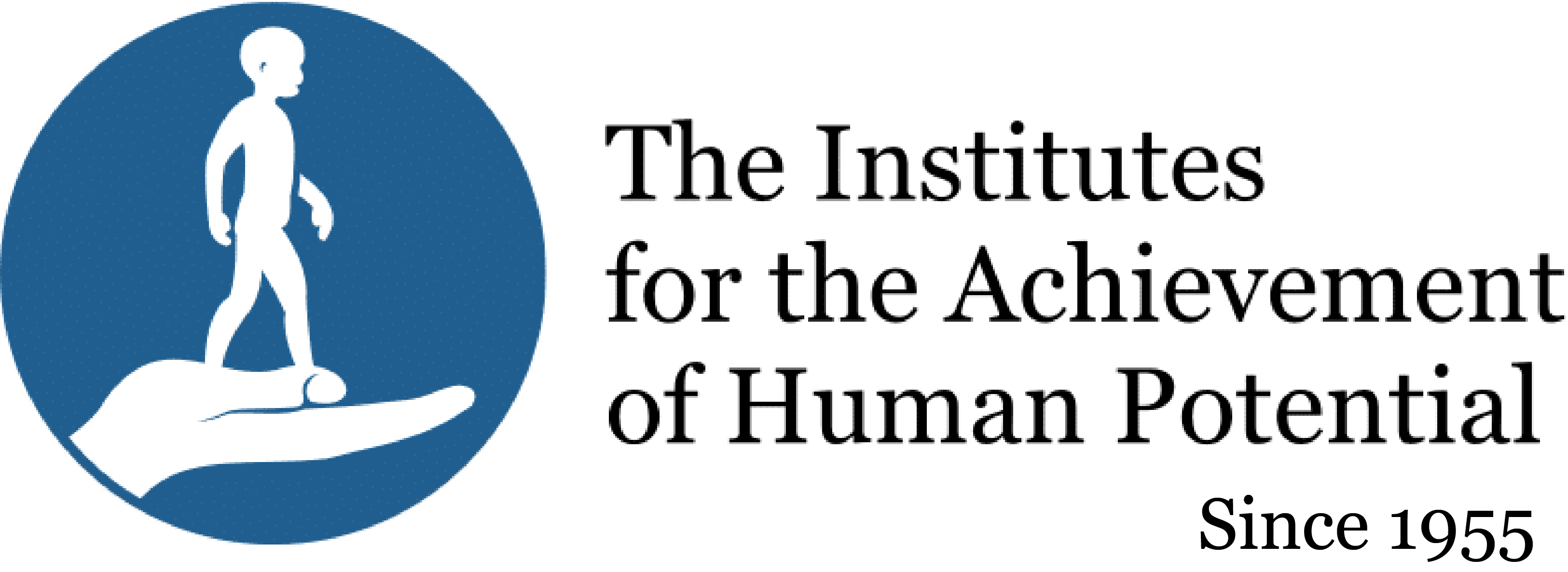
 Donate
Donate


